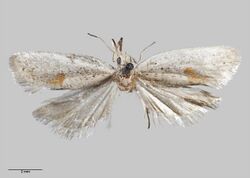Biology:Ericodesma cuneata
| Ericodesma cuneata | |
|---|---|

| |
| Holotype specimen | |
| Scientific classification | |
| Domain: | Eukaryota |
| Kingdom: | Animalia |
| Phylum: | Arthropoda |
| Class: | Insecta |
| Order: | Lepidoptera |
| Family: | Tortricidae |
| Genus: | Ericodesma |
| Species: | E. cuneata
|
| Binomial name | |
| Ericodesma cuneata (Clarke, 1926)[1]
| |
| Synonyms[2] | |
| |
Ericodesma cuneata, the Corokia leafroller moth, is a species of moth in the family Tortricidae. It is endemic to New Zealand. This moth is classified as "At Risk, Naturally Uncommon" by the Department of Conservation.
Taxonomy
This species was first described by Charles E. Clarke in 1926 using a specimen collected by him at Hope Arm, Lake Manapouri and named Tortrix cuneata.[2][3] In 1971 John S. Dugdale assigned Tortrix cuneata to the genus Ericodesma.[4] The holotype specimen is held at the Auckland War Memorial Museum.[2]
Description
Clarke described the species as follows:
♂. 13 mm. Head and thorax light grey; palpi moderate. Antennae grey, antennal ciliations 1⁄2. Abdomen pale ochreous-grey. Forewings elongate, costa moderately arched, apex bluntly pointed, termen slightly rounded, oblique; pale grey with a number of small obscure dots with tendency to form rows; a transverse blunt wedge-shaped red bar at 1⁄2 of dorsum, reaching half-way across wing. Hindwings pale ochreous-grey: cilia pale grey.[3]
Distribution
This species is endemic to New Zealand.[1][5] E. cuneata can be found at Taupō, Otago Lakes and Fiordland.[6] The species, although rare, can be found frequently at The Wilderness in Southland.[7]
Biology and behaviour
The larvae of this species web leaves together on the foliated stems of its host plant.[8]
Host species and habitat
The larvae of E. cuneata feed on Corokia cotoneaster, (korokio).[6] However the moth has not been associated with urban plantings of its host.[6] The adult moth has been collected in beech forest habitat,[3] as well as at strongly leached terraces and plains commonly called "wilderness".[7]
Conservation status
This species has been classified as having the "At Risk, Naturally Uncommon" conservation status under the New Zealand Threat Classification System.[9]
References
- ↑ 1.0 1.1 Gordon, Dennis P., ed (2010). New Zealand Inventory of Biodiversity. Volume two. Kingdom Animalia: Chaetognatha, Ecdysozoa, Ichnofossils. 2. Christchurch, N.Z.: Canterbury University Press. pp. 464. ISBN 9781877257933. OCLC 973607714.
- ↑ 2.0 2.1 2.2 Dugdale, J. S. (1988). "Lepidoptera - annotated catalogue, and keys to family-group taxa". Fauna of New Zealand 14: 117. https://www.landcareresearch.co.nz/__data/assets/pdf_file/0017/26324/FNZ14Dugdale1988.pdf. Retrieved 20 May 2018.
- ↑ 3.0 3.1 3.2 Clarke, Charles E. (1926). "New species of Lepidoptera.". Transactions and Proceedings of the New Zealand Institute 56: 417–421. http://rsnz.natlib.govt.nz/volume/rsnz_56/rsnz_56_00_003980.html. Retrieved 21 May 2018.
- ↑ Dugdale, J. S. (10 November 1971). "Entomology of the Aucklands and other Islands south of New Zealand: Lepidoptera, excluding non-Crambine Pyralidae". Pacific Insects Monograph 27: 55–172. http://hbs.bishopmuseum.org/pim/pdf/pim27-55.pdf.
- ↑ "Ericodesma cuneata (Clarke, 1926)". Landcare Research New Zealand Ltd. http://www.nzor.org.nz/names/de4e1bb0-535e-456c-a683-e313ae011da7.
- ↑ 6.0 6.1 6.2 Patrick, B. H.; Dugdale, J. S. (2000). "Conservation status of the New Zealand Lepidoptera". Science for Conservation (Department of Conservation, New Zealand) 136: 27. ISSN 1173-2946. http://www.doc.org.nz/Documents/science-and-technical/sfc136.pdf. Retrieved 2018-05-21.
- ↑ 7.0 7.1 Dymond, John R., ed (2013). "New Zealand’s naturally uncommon ecosystems". Ecosystem services in New Zealand.. Lincoln, N.Z.: Manaaki Whenua Press. pp. 58. ISBN 9780478347364. OCLC 870683169.
- ↑ "PlantSynz - Invertebrate herbivore biodiversity assessment tool: Database". Landcare Research New Zealand Ltd. 2011. https://plant-synz.landcareresearch.co.nz/ReportForm.aspx?Type=P&SortBy=Alpha&RecordId=556.
- ↑ Hoare, R.J.B.; Dugdale, J.S.; Edwards, E.D.; Gibbs, G.W.; Patrick, B.H.; Hitchmough, R.A.; Rolfe, J.R. (2017). "Conservation status of New Zealand butterflies and moths (Lepidoptera), 2015". New Zealand Threat Classification Series 20: 8. http://www.doc.govt.nz/Documents/science-and-technical/nztcs20entire.pdf.
Wikidata ☰ Q13612491 entry
 |


